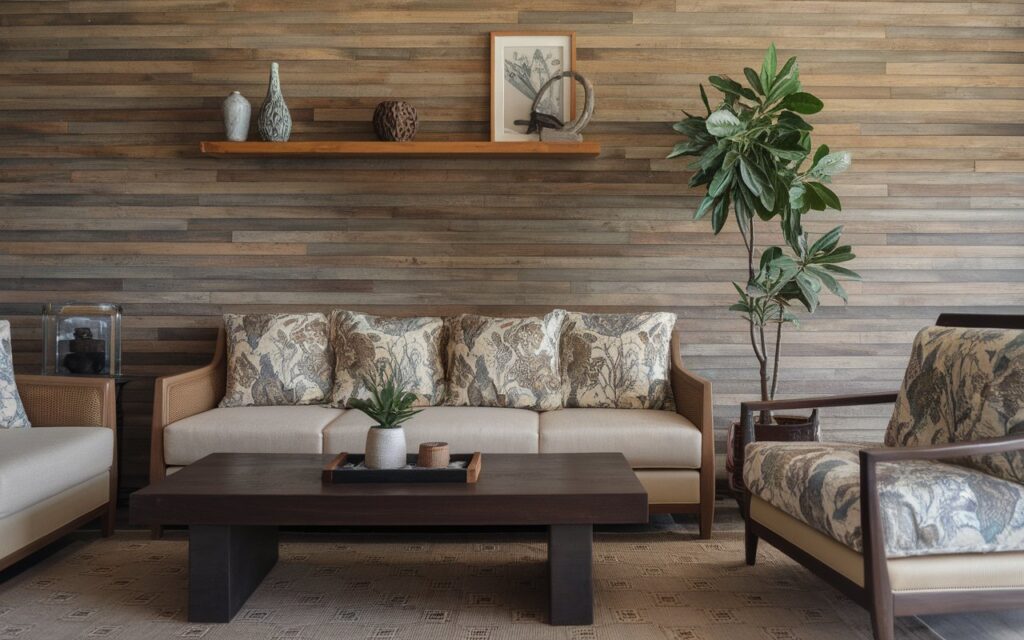When you want to add more warmth and texture to a room, we see that more and more people choose to add wooden wall slat panels to their home. These wooden slat panels are mostly used on the walls, but can be used in many other ways to create a unique and warm atmosphere in any room.
While many people think that wooden panels are simply some panels you attach to your wall as decoration, there are many other creative ways you can style them in your interior. We are going to give you some unique ideas!
Using wooden panels as an room dividers
Of course you can just mount the wooden panels to the wall, but there are different ways to style them in your home. One of the ways to use wooden wall slat panels is as a room divider. You can attach the panels to a freestanding frame of a track on the ceiling. In that way you can create a unique divider that separates different zones of a room without blocking natural light. This is particularly perfect when you have an house with an open plan or when you want to separate zones in a studio. You can also use the wooden slat panels to create a separation between zones you prefer to hide, such as a home office in the room or a place to play for the children.
For example, in an open-plan apartment, someone might use a vertical wooden slat divider to separate the kitchen from the living room, maintaining the feeling of openness while clearly defining each area. In a studio, a slatted partition can create a visual divide between the sleeping area and the workspace without making the space feel closed off. In family homes, slat dividers are also useful for creating quiet reading corners or keeping a messy play area semi-hidden without needing to build a wall.
Adding texture and depth
Another creative way to use wooden wall slat panels is as a ceiling decoration. You can attach the panels on the ceiling, to create a unique and textured ceiling. It will add depth and an eye catcher in the room. This is perfect for rooms with high ceilings and the wooden panels can also create a feeling of coziness and will make the acoustics in the room nicer and better.
Furniture with wooden panels
You can also use wooden slat panels to upgrade your furniture. You can use wooden panels to create a unique headboard or upgrade your TV furniture with it. This can help to integrate the furniture more in your interior and create a sense of unity between all different rooms. By thinking outside the box with where and how to add wooden slat panels, you can add warmth and texture to your space in a unique and creative way.
Slat panels can also influence how a space feels in terms of layout. Vertical lines draw the eye upward and can make a room seem taller, while horizontal placements might have the opposite effect. The direction of the slats, their spacing, and their alignment with other design elements can subtly impact the perception of space. It’s these small visual cues that can shape how open, enclosed, or balanced a room feels.
For instance, in a narrow hallway, vertical slats running floor to ceiling can make the space feel less cramped and more open. In contrast, placing slats horizontally behind a low sofa can elongate the visual width of a room, which might be ideal in smaller apartments. The direction, spacing, and finish of the slats can all be adjusted to suit the proportions of the room and enhance the layout without any structural changes.
Acoustic benefits of wooden slat panels
Incorporating wooden slat panels into interior design also has a practical aspect. Due to their structure, the slats can help with sound absorption, especially in larger rooms where sound tends to echo. While not a complete solution for acoustic issues, the wooden surfaces can contribute to a softer sound environment, which may be especially noticeable in spaces with hard flooring or minimal fabric elements. This functional benefit adds another layer of consideration when deciding where to place them.
Natural aging and maintenance considerations
Over time, materials like wood naturally change in appearance. Exposure to sunlight, humidity, and general wear can lead to slight shifts in color or texture. While some might see this as a drawback, others view it as part of the charm of working with natural materials. It’s worth keeping in mind that wooden slat panels might need occasional maintenance depending on where and how they’re used, particularly in areas exposed to moisture like bathrooms.
For example, oak slats near a large window may slowly develop a richer patina over the years, deepening in tone due to sunlight. In bathrooms, untreated wood might warp or discolor if it’s not properly sealed or maintained, especially in steamy environments. It’s worth considering water-resistant finishes or using engineered wood alternatives if you want to install panels in high-moisture spaces like kitchens or laundry rooms.
Choosing the right tone
Finally, the process of choosing the right wood tone or finish is often guided by the surrounding materials and lighting. Lighter woods tend to reflect more light, which may suit smaller or darker rooms, while darker tones can add contrast and depth. The existing flooring, furniture, and wall colors will all interact with the panels, and sometimes even subtle differences in grain or finish can shift the overall mood of the space.
For example, in a bright Scandinavian-style home, pale ash or birch slats can maintain the airy feel and complement the clean lines of minimalist decor. On the other hand, in a room with darker walls and velvet furniture, something like walnut or smoked oak can add richness and contrast, tying together a more dramatic, cozy look. The wood tone should work in harmony with the rest of your interior to create a cohesive feeling across the space.

